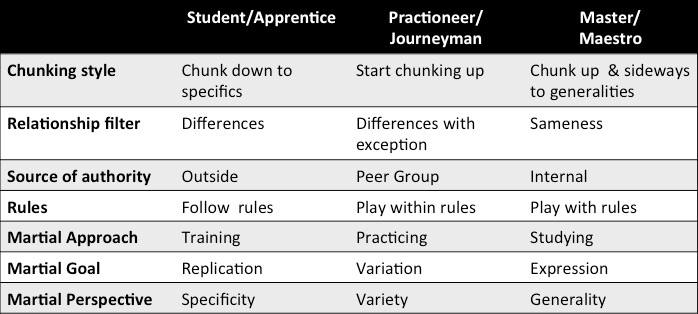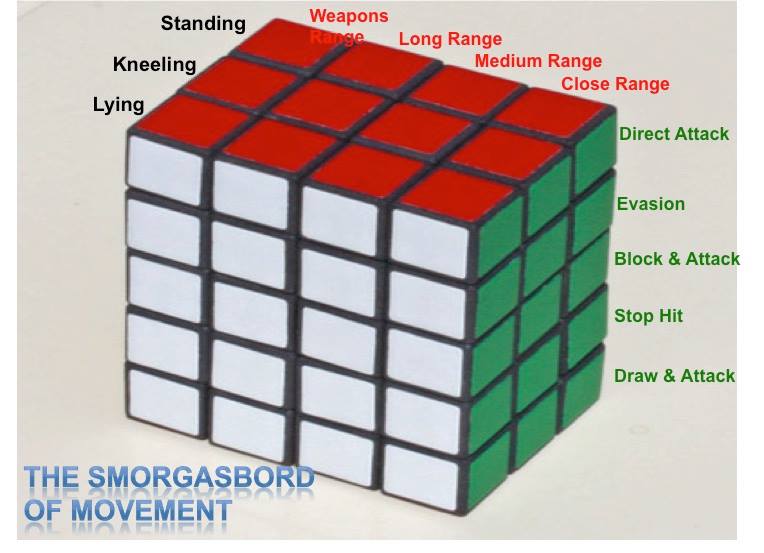"Even after these years of training, I am afraid of the Knife, Sensei!" exclaimed a senior student.
"And you should be. It is your survival instinct kicking in. The real question should be how to channel this fear into a whole new kind of training."
He looked at me a little confused. He wanted easy answers - something I refuse to give. The task at hand now was to open his mind and see how he swims.
So I provoked him: "Attack me with what you fear."
He took the tanto and leaped forward with Angle/Strike 1.
I did a traditional Aikijujutsu parry (Taisabaki 5&6), control (Kansentsuwaza) and disarm.
Wham. Bam. Thank you for the Tanto Sam!
I had him attack again. Angle/Strike 5. This time I met it with a cross block, reversed the knife ('Snaking' for the FMA aficionados), and sent it flying with ease. Then I unleashed a barrage of close range strikes with my 8 limbs.
Knife hand tie. Tanto go fly. Now you Die!
I had him strike again. He made it a thrust. Angle/Strike 4. My body responded. Fingers met the flat edge of the knife and in an instant launched it back into his body. His eyes widened in disbelief.
Meet it. Greet it. Return it!
He stood still. Somewhat in awe, he protested he wouldn't ever be able to do it.
I added emphatically "YET. You cannot do it YET. Yet you will soon."
"How will I remember all the combinations, and know what to do in real time, Sensei? There is no way for me to master all combinations so I can just respond. This is why I am afraid of the blade."
I was reminded of a story from the "Secret Teachings of Self Defense Yamato Ryu Jujutsu" by Jushinsai Sato.
Tetsushu Yamaoka, a famous swordsman, was once asked by one of his friends,"What is the ultimate meaning of your swordsmanship?" Yamaoka-San responded with "I am letting Kwannon-san keep that answer for me." The following day the friend went to the famous Asakusa Temple to see the answer for himself. There he found three ideograms in front of the temple, above his head, which read: Se-Mu-I.
Semui means, "Donate fearlessness to all the sentient beings of the world."
An old teaching story had become real for me. It bought home the role of Bushido, and perhaps the role of a teacher in that moment. The student had opened the door for the teacher to learn as well.
"Fear is natural. It is a friend if you use it, and your worst enemy if it uses you. How we move in the presence of fear makes all the difference. Let us demonstrate something here."
I started to draw a matrix on the mud. On the horizontal axis I laid out 4 Ranges - Weapons, Long, Medium and Short.
I took our basic Tai Sabaki as a way to show how our parries deal with this problem. In the long range we did Ko-ran or cat stepping. In the long to medium range, our basic Ju-Ai or square-cross parries. Now as moved real close we adapted the same concept into JuJi or crossing parries. The students nodded. They had done this many times, and quickly understood it..
Next, I drew the vertical axis with three sections. Standing, Kneeling and Lying. I continued, "Now the TaiSabaki needs to be executed/adapted at these vertical depths as well. You could be attacked at anytime - while standing, sitting or sleeping. This gives you a map of 12 possibilities even within our basic TaiSabaki concept.
I added the 3rd dimension of timing next - the 5 possible timings within our system ( Block, Block and Strike, Stop hit, Feign retreat and counter strike AND pure strike)."
I could see the students shake their heads, that it would be impossible to work all the techniques, let alone gain mastery over it all. I continued to explain that because the whole map of movement is so large some teachers tend to work on a few stylistic preferences. Over time this gets hardened into THE ONLY way of doing things within the school. And if a range/timing of our liking/training does not show up, we are perplexed with what to do next.
The students were getting uncomfortable.
GOOD, perhaps we will all learn something here.
The same disheartened student exclaimed with nervous laughter "Am I just screwed if am not gifted?"
"Or you learn to work towards mastery of your personal movement matrix. Meaning instead of learning different styles for each range or working each technique through the 60 possible combinations (3x4x5), work on the things that that transcend style and schools. Work on the things that can unfold naturally in a given context, rather than working only in the confines of certain stylistic handicaps. This is your personal Vocabulary Of Movement (VOM). And it is a very conscious choice and study."
If you work on unfolding yourself naturally in real time, no matter what the environment, then you stand a chance. Your personal VOM needs to excel at 4 things:
1. Controlling range/distance (How I enter/appear)
2. Seeing the lines/angles and timing (How I respond to transform)
3. Dealing with the 'Oh Shit, I miscalculated' (How I recover and recalibrate)
4. Finishing moves (How I leave/disappear)
There was silence for a bit, and then the question "So why do we learn all these techniques and methods? I mean we have 60 possible ways of moving around the 6 Locks, 9 throws and 2 waza, each with 4 major henka/variations?"
"So you learn all to see possible combinations and respond to any permutations. And as you get better and better, you begin to drop the way of styles and move towards the way of systems. And from here you begin to drop the systems to go towards to the way of martial motion. Smaller. Cleaner. More effective VOM. However you do need the ability to create new movements at will."
This is the journey of transitioning from a Student -> to Practitioner -> to Master. The students follows the rules -> the practitioner plays within the rules -> the master plays with the rules themselves. The student drills down to specifics -> the practitioner chunks up -> the master generalizes.
The authority figures for the student is completely outside onself -> The practitioner's authority is a select peer group -> while the master has bought authority back to oneself.
The mind that began by looking at differences -> then evolves to studying the differences and similarities -> then it finally embraces the similarities while appreciating the stylistic differences
In other words, the journey is towards generalized movements that transcend styles/systems to work exceedingly well for each individual's gifts and handicaps. The journey is not about adding more and more, but about removing all but the essential. This to me the genius, way more fascinating than the entire smorgasbord of any system/system. For the system/style is but the encapsulation of someone else's moment of truth, rather than the one you live by.
So here is my short encapsulation
- Study lines of possible movement (Our system has 10).
- Examine how to appears and disappears from that line fluidly (Taisabaki).
- Transform what has been fed (technique or intent) into a still object that won't be a threat anymore.
To me this is all the movement one needs to make your own. The smorgasbord of our systems movements is huge. You don't have to eat everything. You pick what your body calls out and make it yours. This will leave you healthy and wise. Pick from it what calls you forth each time. Eating everything everytime is perhaps possible, but will definitely leave you feeling like crap and immobile so to speak. The choice is yours - healthy and mobile or crappy and immobile.
The student exclaimed "Then why spend all this time studying the map of 60 possible movements for each waza ? Why not just study the handful of movements that work?"
I recognized the logic from another time in my life, and with laughter, reminded him that there is a reason we study the classics of war: to glean the encapsulated wisdom from them. I reminded him the passage from the "The Prince:"
"A prince being thus obliged to know well how to act as a beast must imitate the fox and the lion, for the lion cannot protect himself from snares, and the fox cannot defend himself from wolves. One must therefore be a fox to recognize snares, and a lion to frighten wolves. Those that wish to be only lions do not understand this."
The students nodded.
Freezing due to fear means death. Learning to move is your best chance of survival. We tend to move in ways we train and study. So spend time in studying how you emerge from the smorgasbord of all possible movements.
"You have fear because you are frozen by all the possible options. This comes from learning material only skin deep. Go deeper, practice it diligently , some of it will sink into your muscles. These methods will be at your command, giving you the ability to relax into them at will. Now study the material that is muscle deep , bringing it into your bones where you own it and can unleash this as though by magic.
This is the age-old metaphor: Go skin-deep with all things, muscle-deep with the patterns that connect, and bone-deep with your pure expressions. As you do this, your fears will let go and you will emerge.
And before we close, fear will tighten your body, freezing you. This means you will be hit and cut more easily. The answer is this dilemma is as best captured by the Bene Gesserit in Dune.
"I must not fear.
Fear is the mind-killer. Fear is the little-death that brings total obliteration.
I will face my fear. I will permit it to pass over me and through me.
And when it has gone past I will turn the inner eye to see its path.
Where the fear has gone there will be nothing.
Only I will remain."
And for you to remain, you got to move like only you can. Go learn and master your VOM.
Until next time remember,
To be the Bomb, own your VOM!
Mahipal Lunia, Sensei
www.MountainViewAiki.com
www.TheRenaissancePath.com
www.MahipalLuniaOutloud.com


